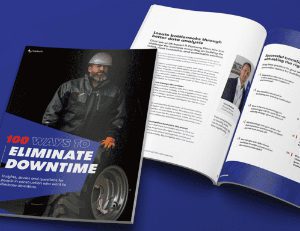

The rise and rise of data has become an increasingly influential factor in the success of many industries in the new century. On the one hand, it has enabled legacy businesses to meet customer needs to greater levels of satisfaction. On the other, it’s facilitated startling new business models to disrupt the status quo with creative destruction.
In the construction sector, companies like Trackunit have instrumented and monitored all kinds of construction processes, collecting data outputs. In our case, through greater understanding of the use of site machines, equipment, and tools, we’ve been able to add more certainty to operational decision-making and deliver greater efficiencies to help meet the industry goal to eliminate downtime.
Most companies have large volumes of data locked up in siloes to serve individual departmental needs of the business, such as human resources and accounting or ERP, CRM and marketing. An extendable data platform gives decision makers a layer of interoperability between independent applications, allowing data to be brought together in a collaborative way and creating a more cohesive and comprehensive view of customers and their needs.
Of course, this begs the question: ‘What is a platform?’ It’s critical that decision makers know exactly why they should have one and what it can do for their business. Stripped down, a platform is an underlying system that supports third-party applications providing a base structure or scaffold if you want to extend the construction analogy to which multiple components can attach. And users — general contractors, subcontractors and other businesses requiring the seamless connection of data across projects — can consolidate information into one collaborative and integrated ecosystem.
That’s because information and knowledge are indelibly locked together. By bringing together information gathered about customers’ individual needs and preferences from a variety of sources, vendors and service providers are better served with unique insights to improve upon existing offerings or develop new products and services to better meet those requirements or identify new markets.

Since building APIs is the optimum way to start to implement extendability to a data platform, it not only offers a route to connecting individual applications being used by the organization, it also holds out a way to connect with other extendable platforms, at the same time allowing third-party developers to build applications to link with yours.
A company which has an extendable data platform as its foundation owns detailed knowledge about its customers drawn from a wide range of sources and available in a usable and dynamic data format. This gives it the potential to be flexible. Proactive in identifying new opportunities to serve the customer’s need better, and able to be quickly responsive to changes in markets or customer preferences.
If this all sounds a bit daunting, then perhaps a glance into everyday life is instructive. Your iPhone, for example, works from a platform. And all those apps you use for music, photos and others on your phone make up that ecosystem. Amazon is the same. So too Uber. Shopify is another (and I’ll return to this particularly interesting example in more detail a little further below).
But recognizing that no single application today meets all business needs, an extendable data platform must meet the following criteria.
The momentum given to digital transformation programs as a result of the pandemic means that configuring and deploying a single extensible data platform makes both economic and management sense. Managing a single platform and keeping it up to data is far easier than multiple platforms.
An extendable data platform adds a layer of interoperability between independent applications, allowing data to be brought together in a collaborative way and creating a more cohesive and comprehensive view of customers and their needs.
Additionally, adding new integrations or features is made more simple without altering source code. In short, it’s easier to extend the functionality of an extendable platform, making innovation faster.
A platform, says one specialist, is a business model which provides the foundation for others to build upon. Making a platform extendable, adds scalability which can benefit a business by adding the dimension of customer insights and information to speed up the cycle of product and service innovation and ultimately, tailored and richer customer experiences which can lead to greater commitment and brand loyalty.
In pure software engineering terms, a cool definition of extendability is “the quality of being designed to allow the addition of new capabilities or functionality.” If it all sounds a little futuristic, it isn’t – evidence shows that it works. Amazon, for example, were able to develop new products such as Echo, and services including Prime, based on information drawn from its e-commerce data.
In the retail sector, a great example of an extendable platform as I mention above is Shopify. Famously, the company’s roots in online shopping stem from its own experiences trying to sell snowboards. Today, the company has built a reputation as one of the “most robust and user-friendly e-commerce platforms on the market…” making life easy for online and in-person stores and shoppers alike.
As an extendable platform, Shopify connects suppliers, vendors, and consumers in a virtuous cycle, making it easy to set up an account, create a website, upload products, set up an online store, make it mobile, start selling via social media, and become an omnichannel legend. At the same time, Shopify is able to take care of other activities to enable vendors and customers to get on with the business of buying and selling by providing services for everything from payment gateways to shipments.
Shopify makes it easy and low cost to get started. It provides options for users to understand their customer needs better, target their marketing with greater optimization and intelligence and build great customer relations.
The construction industry is changing and will need to change faster. It’s not just the pressure of environmental lobbyists and legislators that are driving this, it’s the everyday person in street as well as the many and diverse businesses that comprise our ecosystem that want to see construction unshackled from the things that have help it back in the last century – productivity and (a lack of) profitability.
For a sector that serves the ever-present requirement to meet the accommodation needs of all of mankind including almost every kind of business, at the same time creating public spaces, amenities and venues that contribute to an enhancement in standards of living, construction has to some extent lacked imagination when it comes to doing this in safe, profitable, and sustainable way.
Over the last five years, we have been developing Trackunit Iris as an extendable platform purpose-built for construction. As the world turns to digitalization as a key measure for innovation and sustainability, Iris makes it easy to connect the entire construction ecosystem in one platform, bringing together everything a decision-maker needs to build apps for mobile, web, desktop, and embedded devices that will define the future of construction.
Daily, Trackunit Iris is enriched by millions of data points collected from more than ten thousand different equipment types with over 1.4 million connected assets globally, and more than one billion data points added to a platform which also handles over 40 million API calls each and every day.
Iris makes it easy to connect the entire construction ecosystem in one platform, bringing together everything you need to build apps for mobile, web, desktop, and embedded devices that will define the future of construction.
Trackunit Iris makes Connecting to Construction as simple, borderless, and programmable as the rest of the internet. We’ve taken away a major barrier to your ability to realize your ambitions to innovate.
It’s time to make data, not bricks, the cornerstone of your construction future.
Want to hear more about data, technology, and strategy? The Inside Eliminate Downtime newsletter provides you with insights and three interesting reads once a month. Sign up today.

Never miss an insight. We’ll email you when new articles are published on this topic.


